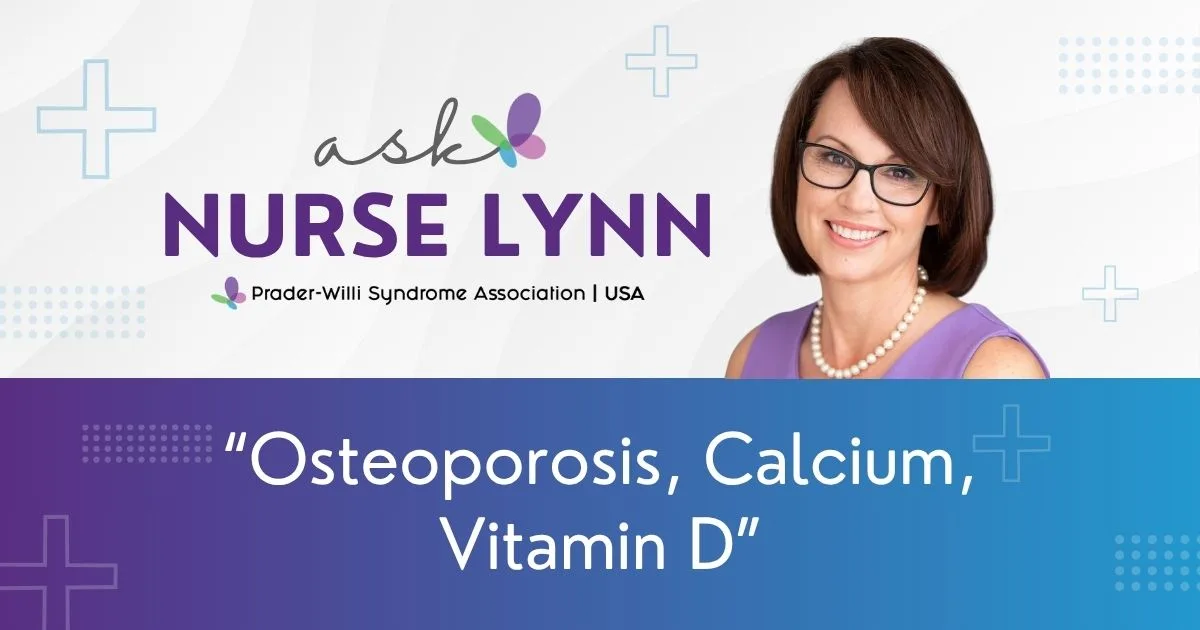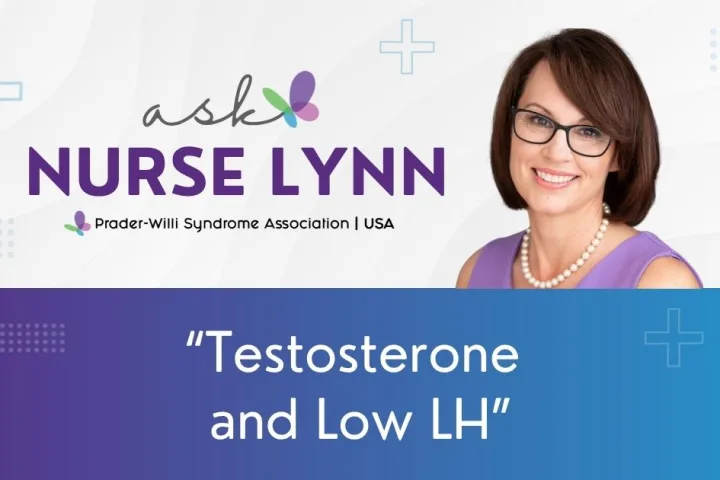Question:
Female, 42 years old, UPD subtype
My question is about treatment for osteoporosis. My sister, to my knowledge, has never had any hormone replacement. She is obese, BMI 38, and the only abnormal lab done by her gynecologist was testosterone, which was “below the technical range of the assay.” Her vitamin D levels are normal, and she takes supplements. She does not appear to take calcium supplements-her PCP says her calcium and Vit D levels are in normal range. Her DEXA scan shows that she’s progressed from osteopenia to osteoporosis. (-4.2) She has no endocrinologist currently, as none will accept her referrals. Her PCP wants to go straight to a yearly infusion of zoledronic acid. I’m concerned about side effects, safety in PWS, alternatives like hormones or supplements-can you help with any guidance?
Nurse Lynn’s Response:
People with PWS are at higher risk for developing osteoporosis, which means their bones become thin and fragile. This is due to several factors, including low hormone levels (especially estrogen and testosterone), lack of growth hormone treatment, low physical activity, weak muscles, and nutritional issues. In women with PWS, estrogen deficiency is very common and often goes untreated. This is especially important because estrogen plays a key role in maintaining strong bones. In your sister’s case, it appears she has never received hormone therapy and has very low testosterone, which likely means she has also been low in estrogen for a long time. That makes her recent diagnosis of osteoporosis—progressing from osteopenia—not surprising.
It’s also important to understand that normal blood levels of calcium and vitamin D do not mean that bones are healthy. Calcium in the blood is kept in a very tight range by the body, even when bones are losing calcium. So, someone can have normal blood calcium but still have weak bones. Similarly, having enough vitamin D in the bloodstream doesn’t guarantee good bone health—especially if estrogen levels are low or if the person isn’t physically active. Osteoporosis is diagnosed by a bone density scan (DEXA), not by blood tests. So even if lab values look fine, bone structure can still be poor.
Because your sister has never been on hormone replacement therapy (HRT), has very low testosterone, and likely has not had enough estrogen for many years, HRT should be seriously considered. Estrogen replacement can slow or even reverse bone loss, help with energy levels and muscle tone, and possibly support metabolism and mood. For women with PWS, hormone therapy may be more important than medications that only treat the symptoms of bone loss. That said, there are some risks to consider. Her high body mass index (BMI of 38), reduced mobility, and possible sleep apnea could increase the risk of complications like blood clots or fluid retention.
Your sister’s doctor has recommended zoledronic acid (Reclast), a once-a-year infusion to strengthen bones and reduce fracture risk. This medication can be helpful, especially if hormone therapy is not available or not appropriate. However, it has some potential side effects. After the first dose, some people experience flu-like symptoms for a few days, which can be hard to manage in someone with developmental disabilities. Kidney function should be checked before giving the medication, since it is processed through the kidneys. There is also a small risk of low calcium levels after the infusion, so it’s important that she gets enough calcium and vitamin D beforehand—even if her blood tests look okay. A dental exam should be done before treatment, since there is a rare risk of jaw problems, especially after dental procedures. Over time, a very small number of people may also develop unusual thigh fractures after using the medication for several years, so ongoing monitoring is needed.
Your sister’s osteoporosis could likely be the result of long-standing hormone deficiency, which is common in PWS. Starting hormone replacement therapy may be a key part of her treatment and could help address the underlying cause of her bone loss. If that’s not possible, zoledronic acid may still offer benefits, but it’s important to take the proper steps to minimize risk and prepare her for treatment. A combination of medical follow-up, supplements, and monitoring will help ensure the safest and most effective approach to protecting her bones.
Resources:
https://www.pwsausa.org/wp-content/uploads/2023/01/Osteoporosis-Evaluation-and-Therapy-in-PWS.pdf
Do you have a non-emergency medical question for Nurse Lynn? Submit your question here:
Share this!





 Perry A. Zirkel has written more than 1,500 publications on various aspects of school law, with an emphasis on legal issues in special education. He writes a regular column for NAESP’s Principal magazine and NASP’s Communiqué newsletter, and he did so previously for Phi Delta Kappan and Teaching Exceptional Children.
Perry A. Zirkel has written more than 1,500 publications on various aspects of school law, with an emphasis on legal issues in special education. He writes a regular column for NAESP’s Principal magazine and NASP’s Communiqué newsletter, and he did so previously for Phi Delta Kappan and Teaching Exceptional Children. Jennifer Bolander has been serving as a Special Education Specialist for PWSA (USA) since October of 2015. She is a graduate of John Carroll University and lives in Ohio with her husband Brad and daughters Kate (17), and Sophia (13) who was born with PWS.
Jennifer Bolander has been serving as a Special Education Specialist for PWSA (USA) since October of 2015. She is a graduate of John Carroll University and lives in Ohio with her husband Brad and daughters Kate (17), and Sophia (13) who was born with PWS. Dr. Amy McTighe is the PWS Program Manager and Inpatient Teacher at the Center for Prader-Willi Syndrome at the Children’s Institute of Pittsburgh. She graduated from Duquesne University receiving her Bachelor’s and Master’s degree in Education with a focus on elementary education, special education, and language arts.
Dr. Amy McTighe is the PWS Program Manager and Inpatient Teacher at the Center for Prader-Willi Syndrome at the Children’s Institute of Pittsburgh. She graduated from Duquesne University receiving her Bachelor’s and Master’s degree in Education with a focus on elementary education, special education, and language arts. Evan has worked with the Prader-Willi Syndrome Association (USA) since 2007 primarily as a Crisis Intervention and Family Support Counselor. Evans works with parents and schools to foster strong collaborative relationships and appropriate educational environments for students with PWS.
Evan has worked with the Prader-Willi Syndrome Association (USA) since 2007 primarily as a Crisis Intervention and Family Support Counselor. Evans works with parents and schools to foster strong collaborative relationships and appropriate educational environments for students with PWS. Staci Zimmerman works for Prader-Willi Syndrome Association of Colorado as an Individualized Education Program (IEP) consultant. Staci collaborates with the PWS multi-disciplinary clinic at the Children’s Hospital in Denver supporting families and school districts around the United States with their child’s Individual Educational Plan.
Staci Zimmerman works for Prader-Willi Syndrome Association of Colorado as an Individualized Education Program (IEP) consultant. Staci collaborates with the PWS multi-disciplinary clinic at the Children’s Hospital in Denver supporting families and school districts around the United States with their child’s Individual Educational Plan. Founded in 2001, SDLC is a non-profit legal services organization dedicated to protecting and advancing the legal rights of people with disabilities throughout the South. It partners with the Southern Poverty Law Center, Protection and Advocacy (P&A) programs, Legal Services Corporations (LSC) and disability organizations on major, systemic disability rights issues involving the Individuals with Disabilities Education Act (IDEA), Americans with Disabilities Act (ADA), and the federal Medicaid Act. Recently in November 2014, Jim retired.
Founded in 2001, SDLC is a non-profit legal services organization dedicated to protecting and advancing the legal rights of people with disabilities throughout the South. It partners with the Southern Poverty Law Center, Protection and Advocacy (P&A) programs, Legal Services Corporations (LSC) and disability organizations on major, systemic disability rights issues involving the Individuals with Disabilities Education Act (IDEA), Americans with Disabilities Act (ADA), and the federal Medicaid Act. Recently in November 2014, Jim retired.